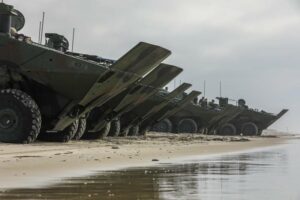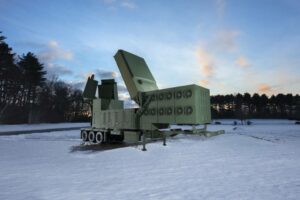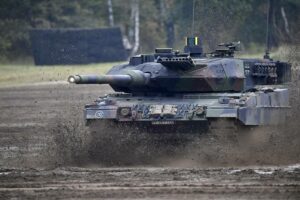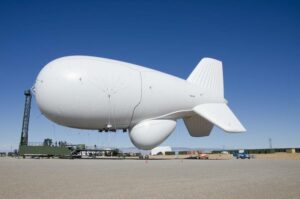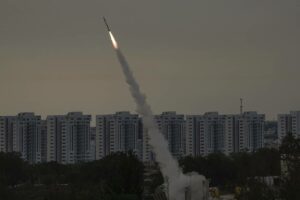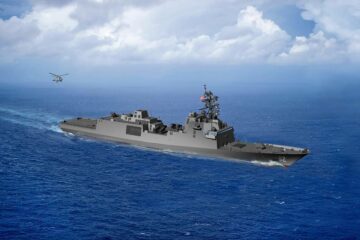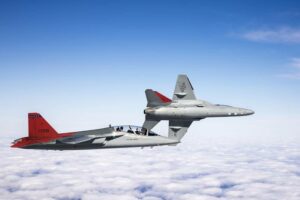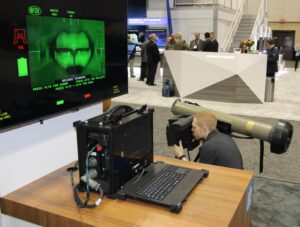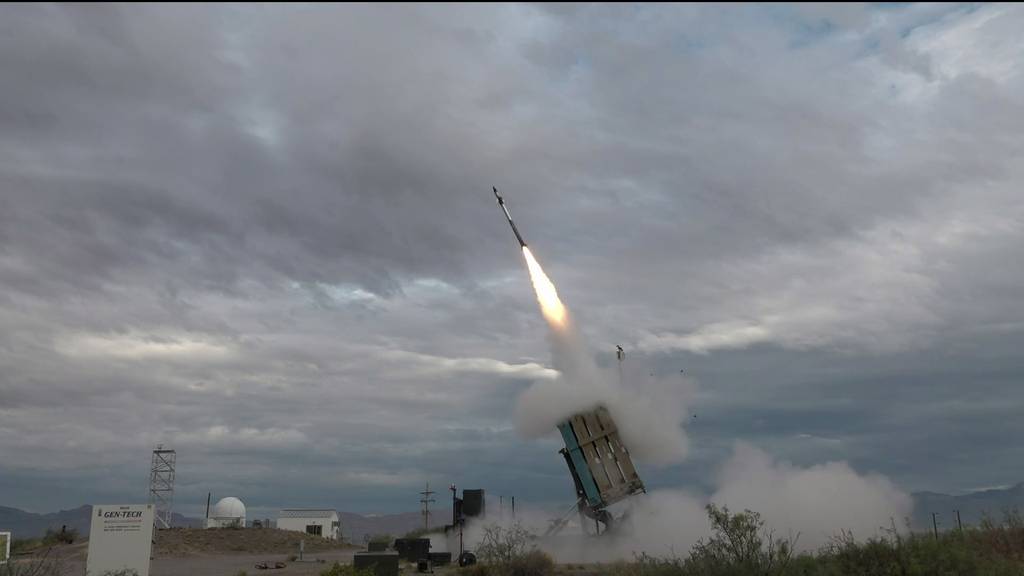
MARINE CORPS BASE QUANTICO, Va. — The U.S. Marine Corps is pushing two air defense systems closer to fielding this year, as emerging threats in Europe and the Middle East highlight the need to keep Marine units safe from incoming missiles and drones.
The Medium-Range Intercept Capability, which rapidly integrated several existing systems to create a new cruise missile defense capability, is moving into training and integration this year ahead of an operational assessment in September. The Corps plans to hand over the first system to 1st Low Altitude Air Defense Battalion in Hawaii in June 2025.
The service also announced this month it successfully tested the Marine Air Defense Integrated System, or MADIS, in December during a live-fire event that saw the system shoot down several drones at the Yuma Proving Ground in Arizona.
Lt. Gen. Karsten Heckl, the deputy commandant for combat development and integration, told Defense News in a Jan. 12 interview that integrated air and missile defense is becoming increasingly important for the service’s future operating plans and its Force Design modernization initiative.
“When you look at how we’ve approached [integrated air and missile defense] from a Force Design perspective, it’s got to be layered defense, and so the MRIC [Medium-Range Intercept Capability] is complementary and overlaps our MADIS and [Light] MADIS,” he said.
Heckl added that a critical concern former Commandant Gen. David Berger and current Commandant Gen. Eric Smith had about Force Design is the ability to defend small units on the forward edge — or inside an enemy’s weapons engagement zone.
“The MRIC is going to be a critical piece of that,” Heckl said.
Pointing to ongoing missile and drone attacks in the Red Sea as well as ashore in the Middle East, Heckl said the integrated air and missile defense model is already at play among the joint force: U.S. and allied naval ships are shooting down what they can at sea, but ground units in Iraq, for example, have still come under attack by incoming aerial threats. MRIC and MADIS would provide additional layers of defense for these units once fielded, he said, supplementing the broader protection Navy assets can provide to the region.
What matters “is how that Marine force … is nested within the larger joint force. So I think we’re seeing a real-world live view of that happening in the Middle East, and I think it’s working pretty doggone good.”
A new anti-missile system
The MRIC system will go from concept to fielding in about five years, due to its use of existing systems: the AN/TPS-80 Ground/Air Task-Oriented Radar; the Common Aviation Command and Control System; the Tamir interceptor missile and an associated battle management system used in the Iron Dome defensive system in Israel; and a repurposed resupply trailer of the High Mobility Artillery Rocket System.
Lt. Col. Matthew Beck, the product manager for MRIC, told Defense News the system had performed well in several live-fire events, but noted that personnel from the equipment manufacturers and the program office had run them. The next step, he said, is to train a low-altitude air defense battalion to use the gear and to conduct their own operations without outside help.
Though the Corps hasn’t identified which unit will participate in this year’s training and the operational assessment in September, he said it will include low-altitude air defense battalion members, who will manage the intercept with help from a Marine aircraft control group to operate the G/ATOR radar. Those units, once identified, will undergo “significant training events” ahead of the September test, he added.
From there, 1st Low Altitude Air Defense Battalion will prepare to accept the new equipment, scheduled for June 2025. Beck said the Corps hopes to spread the capability to the rest of the fleet as rapidly as possible after that.
Heckl agreed he’d like to see MRIC fielded quickly but noted his main concern was “outstripping industrial base capability” to build the interceptor missile. He didn’t want units with empty launchers, he said.
To that end, Tamir builder Rafael Advanced Defense Systems has teamed up with RTX — formerly known as Raytheon Technologies — to build the interceptor missiles at Camden, Arkansas.
RTX spokeswoman Briana Gabrys told Defense News that a new production facility’s design and construction plans are in the works, and that factory test equipment was already ordered. The facility is expected to open in 2025.
She declined to disclose how many interceptors this new production line will build, but said it will produce enough missiles to support the U.S. Marine Corps, Israel and other international customers.
The American-built interceptors will be dubbed SkyHunter, but will be identical to Tamir missiles, which can shoot down cruise missiles, crewed aircraft, drones, rockets, artillery and mortars.
Global threats
MRIC is meant to protect fixed and semi-fixed locations, but users can move it with the help of a Medium Tactical Vehicle Replacement. MADIS, on the other hand, is mounted atop a pair of Joint Light Tactical Vehicles and can provide a close-in protection to forces on the forward edge. One piece of the system detects incoming drones and small aircraft; the other shoots Stinger missiles and a 30mm cannon.
The December test in Arizona subjected the system to “actual battlefield scenarios,” according to a Marine Corps news release.
The system will go through additional live-fire testing, new equipment training, system verification testing, and initial operational test and evaluation between now and September.
If successful, the 3rd Littoral Anti-Air Battalion will received MADIS. That battalion provides air defense to the 3rd Marine Littoral Regiment, which is at the heart of the Marine Corps’ stand-in force in the Pacific.
Both of the air defense systems are important to the Marines’ Force Design modernization effort. The service plans to send small units to dispersed locations throughout the Pacific region as a deterrence to China.
Critics of Force Design and its chief architect, former Commandant Berger, have long argued the service is developing a force that’s only applicable to a Pacific-based fight. But Heckl said ongoing conflicts in the Middle East and Europe justify decisions made under Force Design.
“We have an axis of evil — Russia and the [Chinese Communist Party] are openly aligned, and now we’ve got Iran, North Korea, North Korea supplying Russia, Iran is supplying the Houthis,” he said. “It’s becoming less and less an issue of separating the CCP from anybody else” because technology is being shared among these countries and militant groups.
As a result, all the threats Marines were preparing for in the Pacific could be — and in some cases already are — used in other theaters.
“What we’re seeing bear itself out in the Middle East right now conceptually supports the direction [of Force Design],” Heckl said, citing loitering munitions, drone swarms and unmanned surface vessels. “So all these concerns clearly are a physical manifestation now of what we thought” Marines needed to prepare for in the Pacific and elsewhere.
Megan Eckstein is the naval warfare reporter at Defense News. She has covered military news since 2009, with a focus on U.S. Navy and Marine Corps operations, acquisition programs and budgets. She has reported from four geographic fleets and is happiest when she’s filing stories from a ship. Megan is a University of Maryland alumna.
- SEO Powered Content & PR Distribution. Get Amplified Today.
- PlatoData.Network Vertical Generative Ai. Empower Yourself. Access Here.
- PlatoAiStream. Web3 Intelligence. Knowledge Amplified. Access Here.
- PlatoESG. Carbon, CleanTech, Energy, Environment, Solar, Waste Management. Access Here.
- PlatoHealth. Biotech and Clinical Trials Intelligence. Access Here.
- Source: https://www.defensenews.com/land/2024/01/17/us-marines-rush-to-field-two-air-defense-systems-amid-global-threats/
- :has
- :is
- $UP
- 11
- 12
- 13
- 1st
- 2023
- 2024
- 2025
- 27
- 3rd
- 7
- 70
- a
- ability
- About
- Accept
- According
- acquisition
- added
- Additional
- advanced
- After
- agreed
- ahead
- AIR
- aircraft
- aligned
- All
- already
- also
- Amid
- among
- an
- and
- announced
- applicable
- ARE
- argued
- arizona
- AS
- assessment
- Assets
- associated
- At
- attack
- Attacks
- aviation
- Axis
- base
- Battle
- Battlefield
- BE
- Bear
- because
- becoming
- being
- Berger
- between
- broader
- Budgets
- build
- builder
- but
- by
- CAN
- capability
- cases
- ccp
- Center
- China
- chinese
- Chinese Communist Party
- citing
- clearly
- closer
- combat
- come
- Common
- complementary
- Conceptually
- Concern
- Concerns
- Conduct
- conflicts
- construction
- control
- could
- countries
- covered
- create
- critical
- cruise
- Current
- Customers
- David
- Davis
- dec
- December
- decisions
- Defense
- defensive
- deputy
- Design
- developing
- Development
- direction
- Disclose
- dispersed
- Display
- down
- drone
- Drones
- dubbed
- due
- during
- East
- Edge
- effort
- elsewhere
- emerging
- empty
- end
- engagement
- enough
- equipment
- eric
- Europe
- evaluation
- Event
- example
- existing
- expected
- Facility
- factory
- field
- fight
- Filing
- Fire
- First
- five
- fixed
- FLEET
- Focus
- For
- Force
- Forces
- Former
- formerly
- Forward
- four
- from
- future
- future operating
- Gear
- Gen
- General
- geographic
- Global
- Go
- going
- good
- got
- Ground
- Group
- Group’s
- had
- hand
- Happening
- Have
- hawaii
- he
- Heart
- help
- High
- Highlight
- his
- hopes
- How
- HTTPS
- i
- identical
- identified
- images
- important
- in
- In other
- include
- Incoming
- increasingly
- industrial
- initial
- Initiative
- inside
- integrated
- integration
- International
- Interview
- into
- Iran
- iraq
- Israel
- issue
- IT
- ITS
- itself
- Jan
- joint
- jpg
- june
- Keep
- known
- korea
- larger
- layered
- layers
- less
- light
- like
- Line
- live
- locations
- Long
- Look
- Low
- made
- Main
- manage
- management
- management system
- manager
- Manufacturers
- many
- Marine
- Maryland
- Matters
- matthew
- meant
- medium
- Megan
- Members
- Michael
- Middle
- Middle East
- Military
- missiles
- mobility
- model
- modernization
- Month
- move
- moving
- Need
- needed
- New
- news
- news release
- next
- North
- North Korea
- noted
- now
- of
- Office
- on
- once
- ONE
- ongoing
- only
- open
- openly
- operate
- operating
- operational
- Operations
- or
- Other
- our
- outside
- over
- own
- Pacific
- pair
- participate
- party
- Personnel
- perspective
- physical
- piece
- plans
- plato
- Plato Data Intelligence
- PlatoData
- Play
- possible
- Prepare
- preparing
- pretty
- produce
- Product
- product manager
- Production
- Program
- Programs
- protect
- protection
- prototype
- provide
- provides
- proving
- Pushing
- quickly
- radar
- Rafael
- rapidly
- real world
- received
- Red
- region
- release
- replacement
- Reported
- reporter
- REST
- result
- right
- rocket
- Run
- rush
- Russia
- s
- safe
- Said
- saw
- scenarios
- scheduled
- SEA
- see
- seeing
- seen
- send
- separating
- sept
- September
- service
- set
- several
- shared
- she
- ship
- ships
- Shoot
- shooting
- since
- small
- smith
- So
- some
- spread
- Step
- Still
- Stories
- successful
- Successfully
- supplying
- support
- Supports
- Surface
- system
- Systems
- tactical
- teamed
- Technologies
- Technology
- test
- tested
- Testing
- that
- The
- the joint
- their
- Them
- There.
- These
- they
- think
- this
- this year
- those
- threats
- Through
- throughout
- to
- told
- trailer
- Train
- Training
- two
- u.s.
- U.S. Navy
- under
- undergo
- unit
- units
- university
- University of Maryland
- us
- use
- used
- users
- vehicle
- Vehicles
- Verification
- View
- virginia
- want
- was
- we
- Weapons
- WELL
- were
- What
- when
- which
- WHO
- will
- with
- within
- without
- working
- works
- would
- year
- you
- zephyrnet


